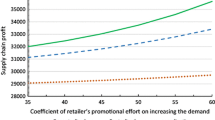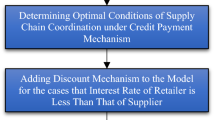Abstract
The problem is to determine a review period and stocking policy that are mutually beneficial to a producer and a retailer. In our model, the retailer uses a periodic review, base stock policy for ordering the item from the producer's Distribution Center (DC). Excess customer demand is assumed to be lost. A make-to-order production system supplies to the DC. We show that given a review period, unless the manufacturer agrees to share the cost of carrying a fraction of the safety stocks at the retailer, the two will not agree upon the level of stocks to be carried in the store. We prove that there is an equilibrium value for this fraction, such that the retailer and the manufacturer are always in agreement with regard to the stocking level. We then show that complete coordination on the stocking level as well as the review period can be achieved solely through carrying out negotiations on credit terms. These theoretical results are used to construct an algorithm for calculating the optimal policy parameters for a supply chain. As part of the analysis we suggest a modification of the base stock policy for the positive lag lost sales case of periodic review inventory models that consistently outperforms the base stock policy in our numerical studies.
Similar content being viewed by others
References
Gupta, Y.P. and Neel, G.A. (1992) The origin of EDI and changes associated with its implementation. IIE Solutions, 24(8), 25–29.
Wang, E.T.G. and Seidmann, A. (1995) Electronic data interchange: competitive externalities and strategic implementation policies. Management Science, 41, 401–418.
Goyal, S.K. and Gupta, Y.P. (1989) Integrated inventory models: the buyer-vendor coordination, European Journal of Operational Research, 41, 261–169.
Dolan, R.J. (1987) Quantity discounts: managerial issues and research opportunities, Marketing Science, 30, 1–22.
Monahan, J.P. (1984) A quantity discount pricing model to increase vendor profits. Management Science, 30, 720–726.
Joglekar, P.N. (1988) Comments on ``A quantity discount pricing model to increase vendor profits. Management Science, 34, 1393–1398.
Dada, M. and Srikanth, K.N. (1987) Pricing policies for quantity discounts, Management Science, 33, 1247–1252.
Lee, H.L. and Rosenblatt, M.J. (1986) A generalized quantity discount pricing model to increase supplier's profits. Management Science, 32, 1177–1185.
Weng, Z.K. (1995) Channel coordination and quantity discounts. Management Science, 41, 1509–1522.
Kohli, R. and Park, H. (1994) Coordinating buyer-seller transactions across multiple products. Management Science, 40, 1145–1150.
Spengler, J. (1950) Vertical integration and anti-trust policy. Journal of Political Economy, 58, 347–352.
Anupindi, R. and Bassok, Y. (1994) Centralization of stocks: retailer vs. manufacturer. Technical Report, J. L. Kellog School of Management, Northwestern University, Evanston, IL 60208.
Parlar, M. (1988) Game theoretic analysis of the substitutable product inventory problem with random demands. Naval Research Logistics, 35, 397–409.
Wang, Q. and Parlar, M. (1994) A three-person game theory model arising in stochastic inventory control theory. European Journal of Operational Research, 76(1), 83–97.
Ernst, R. and Cohen, M.A. (1992) Coordination alternatives in a manufacturer/dealer/inventory system under stochastic demand. Production and Operations Management, 1, 254–268.
Ernst, R. and Powell, S.G. (1992) Manufacturer's incentives to improve retail service levels. Working Paper number 282, (1987) The Amos Tuck School of Business Administration, Dartmouth College, NH 03755.
Pasternak, B.A. (1985) Optimal pricing and return policies for perishable commodities. Marketing Science, 4, 166–176.
Kandel, E. (1996) The right to return, Journal of Law and Economics, 39, 329–56.
Padmanabhan, V. and Png, I.P.L. (1997) Manufacturer's return policies and retail competition. Marketing Science, 16, 81–94.
Allen, S.G. (1958) Redistribution of total stock over several user locations, Naval Research Logistics Quarterly, 5, 51–59.
Clark, A.J. and Scarf, H.E. (1960) Optimal policies for a multiehelon inventory problem. Management Science, 6, 475–490.
Clark, A.J. and Scarf, H.E. (1962) Approximate solutions to a simple multi-echelon inventory problem in Studies in Applied Probability and Management Science, Arrow, K.J., Karlin S. and Scarf, H. (eds.), Stanford University Press, Stanford, CA, pp. 88–100.
Federgruen, A. and Zipkin, P. (1984) Approximations of dynamic multilocation production and inventory problems. Management Science, 30(1), 69–84.
Nahmias, S. (1993) Mathematical models of retailer inventory systems: an overview, in Perspectives in Operations Management: Essays in Honor of Elwood S. Buffa, Sarin, R.K. (ed.), Kluwer Academic Press, Boston, MA. pp. 249–278.
McGavin, E.J., Schwarz, L.B. and Ward, J.E. (1993) Two-interval inventory allocation policies in a one-warehouse N-identical retailer distribution system. Management Science, 39, 1092–1107.
Nahmias, S. and Smith, S.A. (1994) Optimizing inventory levels in a two-echelon retailer system with partial lost sales. Management Science, 40, 582–596.
Hadley, G. and Whitin, T.M. (1963) Analysis of Inventory Systems, Prentice Hall, Englewood Cliffs, NJ, pp. 237–242.
Buzacott, J.A. and Shanthikumar, J.G. (1993) Stochastic Models of Manufacturing Systems, John Wiley, NY.
Silver, E.A. and Peterson, R. (1985) Decision Systems for Inventory Management and Production Planning, 2nd. ed., John Wiley, NY, p. 290.
Karlin, S. and Scarf, H.E. (1958) Optimal inventory policy for the Arrow-Harris-Marschak dynamic model with a time lag in Studies in the Mathematical Theory of Inventory and Production, Arrow, K.J., Karlin, S. and Scarf, H. (eds.), Stanford University Press, Stanford, CA, Ch. 10, pp. 155–178.
Kaplan, R. (1970) A dynamic inventory model with stochastic lead times, Management Science, 16, 491–507.
Morton, T.E. (1971) The near-myopic nature of the lagged-proportional-cost inventory problem with lost sales. Operations Research, 19, 1708–1716.
Nahmias, S. (1979) Simple approximations for a variety of dynamic lead-time lost-sales inventory models. Operations Research, 27, 904–924.
Ehrhardt, R. (1984) (s; S) policies for a dynamic inventory model with stochastic lead-times. Operations Research, 32, 121–132.
Zipkin, P. (1986) Stochastic lead-times in continuous-time inventory models. Naval Research Logistics Quarterly, 33, 763–774.
Hax, A.C. and Candea, D. (1984) Production and Inventory Management, Prentice-Hall, Englewood Cliffs, NJ.
Wilson, R. (1968) The theory of syndicates. Econometrica, 36, 119–132.
Kohli, R. and Park, H. (1989) A cooperative game theory model of quantity discounts. Management Science, 35, 693–707.
Morton, T.E. and Pentico, D. (1995) The finite horizon nonstationary stochastic inventory problem: near myopic bounds, heuristics and testing. Management Science, 41, 334–343.
Hart, O. and Holmstrom, B. (1987) The theory of contracts, in Advances in Economic Theory, Bewley T. (ed), Cambridge University Press, Cambridge, UK, Ch. 3, pp. 71–159.
Farrell, J. (1987) Information and the Coase theorem, Economic Perspectives, 1, 113–129.
van Damme, E. (1996) Stability and Perfection of Nash Equilibrium, 2nd edn., Springer-Verlag, Berlin.
Elsgolts, L. (1970) Differential Equations and the Calculus of Variations, Mir Publishers, Moscow.
Author information
Authors and Affiliations
Rights and permissions
About this article
Cite this article
Moses, M., Seshadri, S. Policy mechanisms for supply chain coordination. IIE Transactions 32, 245–262 (2000). https://doi.org/10.1023/A:1007646531546
Issue Date:
DOI: https://doi.org/10.1023/A:1007646531546




